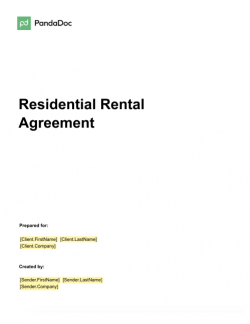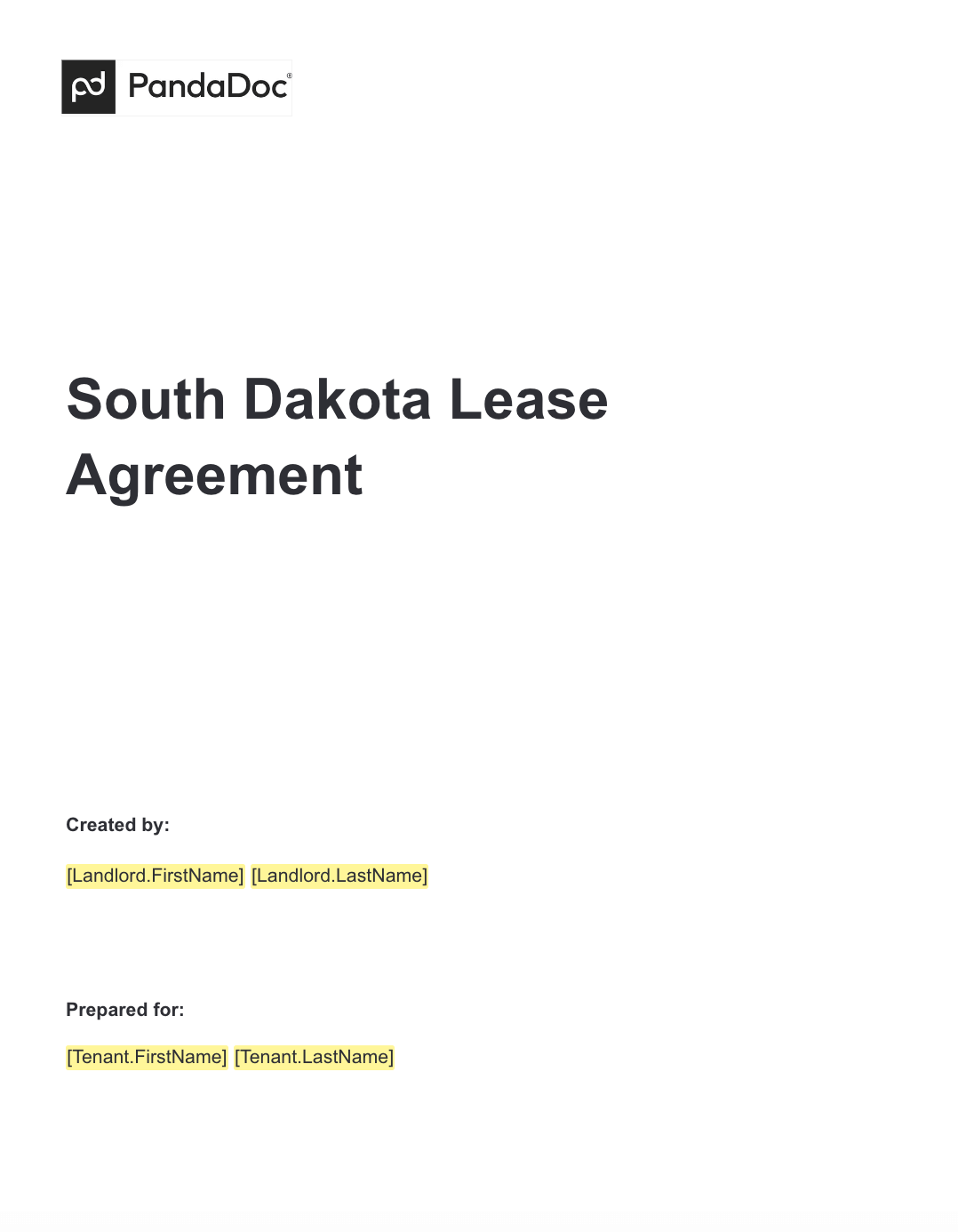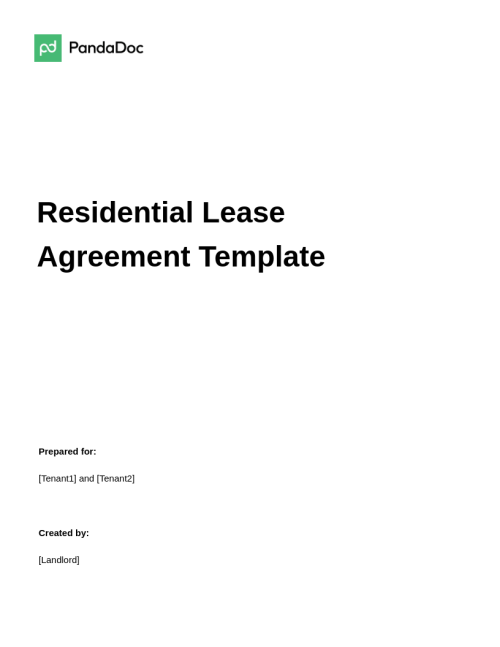Key Takeaways
- Lease Agreements serve as a guiding document when you’re leasing or renting out your property, outlining the key elements of the transaction.
- These contracts can vary depending on the type of lease, its duration, and the property involved, each carrying its legal implications.
- Pre-structured templates are available, providing a framework that fits your leasing situation and eliminating the need for extensive modifications.
- Selecting a template that aligns with your state’s laws ensures landlords and tenants are legally protected and clear about their rights and responsibilities. In this case, South Dakota.
- PandaDocprovides clarity and legal safeguarding, offering complimentary South Dakota Lease Agreement Templates for crafting detailed contracts.
South Dakota Lease Agreement Templates
Residential Lease Agreement

Residential Rental Agreement
Used 5,261 times
Save time and resources by using this customizable residential rental agreement to create legally binding contracts with your tenants. It includes detailed sections about all aspects of a typical tenancy, including terms, responsibilities, rent, duration, insurance, maintenance, and more.
This agreement establishes the terms and conditions for renting residential properties in South Dakota.
South Dakota Apartment Lease
Tailored for apartment rentals in South Dakota, this lease agreement outlines specific details such as rent, utilities, and lease duration.
South Dakota Room Rental
Designed for renting out individual rooms within a property, this template helps landlords and tenants in South Dakota establish clear guidelines for shared living spaces.
South Dakota Month-to-Month Lease
Offering flexibility without a long-term commitment, this lease agreement allows for short-term rental arrangements in South Dakota, providing both landlords and tenants with the freedom to adjust rental terms as needed.
Commercial Lease Agreement
This agreement is crafted for leasing commercial properties in South Dakota, covering essential aspects such as lease terms, rent adjustments, and property use restrictions.
Lease to Purchase Agreement
Providing a structured framework for lease-to-own arrangements, this agreement offers tenants in South Dakota the option to purchase the property in the future.
Sublease Agreement
Facilitating subleasing arrangements, this agreement ensures clarity and professionalism between the original tenant and the subtenant.
Understanding South Dakota Rental Laws
If you’re living in South Dakota, it’s important to know that various legal rules can influence the relationship between a landlord and a tenant and the terms of a rental agreement. Whether you’re a tenant interested in understanding your housing conditions or a landlord striving to adhere to the law, knowing the state statutes and any rules specific to your location is crucial. For instance, the duties of a landlord in South Dakota are shaped by a series of state laws that cover a wide range of topics, from property upkeep to the rules regarding security deposits.
| Laws | Name | Description |
| SDC 1939, § 38.0401 | General Provisions | It encompasses key components like the proposal and agreement, the exchange of value, and the ability of the involved parties to form contracts. |
| §§ 43-32-1 to 43-32-30 | Possession and renting of property | It delineates the privileges and duties of both landlords and tenants, encompassing areas like the payment of rent, upkeep of the property, and the tenant’s entitlement to peaceful occupancy. |
| SDCL §§ 43.32-6.1 and 43-32-24 | Security deposits | It governs the gathering, management, and reimbursement of security deposits, which includes the maximum permissible sums and detailed deductions. |
| §§ 43-32-18 | Termination notice | It sets forth the notification prerequisites for landlords and tenants to end lease agreements. |
| §§ 43-32-32 | Landlord’s right of entry | It defines the circumstances in which landlords are permitted to access rented properties, safeguarding tenants’ privacy rights. |
Security Deposit Limits
- In South Dakota lease agreements, landlords aren’t limited to the amount they can request for a security deposit, but it should be reasonable.
- In South Dakota, no law prevents using a security deposit to cover unpaid rent.
- Landlords can include a clause in the lease agreement stating that the security deposit cannot be applied to the final month’s rent until the tenant has moved out of the rental unit.
- After the lease term ends and the tenant provides a forwarding address or delivery instructions, landlords in South Dakota must return the security deposit and a written notice within 14 days.
- Unlike some states, such as New Jersey, South Dakota landlords aren’t required to pay interest on security deposits.
- Landlords must provide a written notice to the tenant within 14 days after the lease term ends, and the tenant must provide a forwarding address. The notice should include the security deposit amount due back to the tenant, if any, along with a written explanation for any deductions.
- If the tenant requests, the landlord must provide a more detailed, itemized list of deductions within 45 days after the lease term ends.
- If landlords fail to return the security deposit within 14 days, tenants can take legal action to recover the full security deposit plus damages up to $200 and court costs.
- Tenants can also sue a landlord for failing to provide a written statement when deductions are made, failing to provide an itemized accounting (if requested), or making unreasonable deductions.
Eviction Procedures
- The landlord issues an eviction notice that lasts from zero (0) to three (3) days.
- The landlord initiates an eviction lawsuit in court.
- The court delivers a summons to the tenant.
- The tenant submits a response.
- The landlord and tenant attend a court hearing, and a judgment is made.
- The tenant receives a final notice period to vacate the property.
- The sheriff comes back to forcibly evict the tenant.
Under South Dakota law, reasons for eviction include non-payment of rent, lease violations, overstaying after the lease has ended, causing damage to the property, or unlawfully possessing and keeping any real estate.
Right to Enter (Landlord)
- Standard Access – For non-emergency situations, the landlord must give at least 24 hours’ notice before entering the tenant’s property.
- Immediate Access – In an emergency, the landlord can enter the tenant’s property without prior notice.
Disclosures
Landlords in South Dakota need to be mindful of two mandatory disclosures, one enforced by federal legislation and the other by state legislation:
- Lead-Based Paint Disclosure – Landlords in South Dakota need to be aware that if the property they are renting out was constructed prior to 1978, they’re obligated to notify the tenant about the potential presence of lead-based paint inside the property. This is a requirement under federal law.
- Methamphetamine Production Disclosure – If the property being leased was previously used for the production of methamphetamine, state law mandates that the landlord must share this information with prospective tenants.



